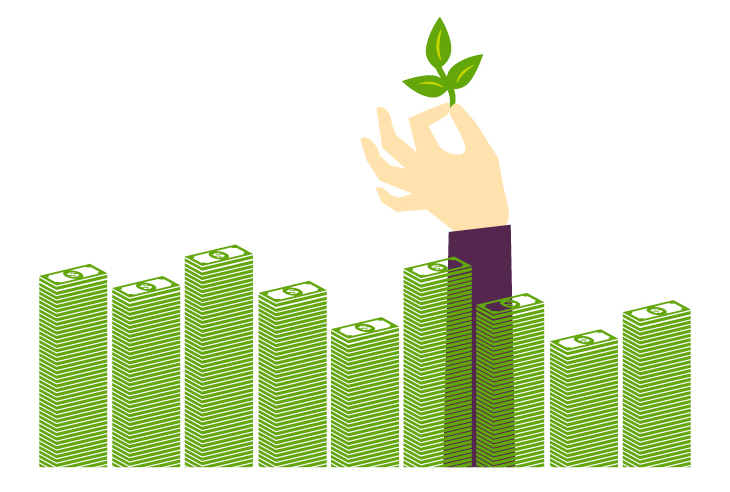How to Build Ambitious Climate Action into your Portfolio
John Bai explains 3.5 simple steps investors can take to put their portfolio not only on a path to lower carbon emissions, but on a path to positive impact. Not only can investors avoid fossil fuels, they can actively invest in renewable energy and energy transitions to fund a greener future.
When we look at the dollar figure connected to the world’s plan to reach net zero carbon emissions by 2050, the mind reels. The Glasgow Financial Alliance for Net Zero estimates it will require a $125 trillion investment. It’s beyond overwhelming. That is why the world needs every single investor, no matter how large or small their portfolio, to participate in this collective effort. But how, exactly?
“It’s a long way to $125 trillion, but if we all pull together, I believe we can make it.”
John Bai
In this article, I outline simple steps investors can take to put their portfolio not only on a path to lower carbon emissions, but on a path to positive impact. This is portfolio construction for the responsible investor who believes it’s not only possible, but necessary, to take immediate action on climate while seizing one of the greatest investment opportunities of the century.
Portfolio design can be as complicated as you (or your advisor) want to make it. Here we boil it down to three steps, with a bonus step that’s largely reserved for institutional investors. Our focus is on the use of investment funds as opposed to individual stocks and bonds.
Step 1: Begin at the Beginning
No portfolio should be built without first establishing clear long-term goals, an understanding of one’s appetite for risk, and a time horizon. Once this foundation is set, you are ready to strategically allocate your assets.
Will you build a classic 60/40 equity/fixed income portfolio? A more aggressive 80/20? Or a conservative 25/75? Strategic asset allocation, diversification, risk management, rebalancing—these time-tested activities remain as important as ever.
Step 2: Select Building Blocks
It’s time to select the investments expected to achieve your financial goals, while also making a positive impact on real-world carbon emissions.
Climate-focused funds generally fall into two categories: thematic investing, and impact investing. There can be overlap, but there is also a key difference. An impact fund is designed to drive measurable change toward a specific, stated outcome, and to report on progress along the way. A thematic fund does not necessarily take the same outcome-oriented approach, though its overall objective—such as investing to reduce carbon emissions—could be similar.
Impact bonds are especially effective. That’s because proceeds from the issuance of the bonds are used to fund a defined project, so investors can tell exactly what their money is being used for. A bond could be issued to raise money for housing, for example, or to improve water treatment facilities. But not all impact bonds are the same.

Consider a bond where proceeds are used to reduce carbon emissions of a global shipping fleet. Sounds great on the surface. But what if the ships were oil tankers, carrying hundreds of thousands of barrels of oil around the world? Due diligence is always required.
Caution is warranted regarding the phrase ‘decarbonizing your portfolio.’ It is useful language for cracking the shell of the problem, but not for getting to the heart of it. You could easily exclude heavy-emitting industries from your portfolio and immediately tick the low-carbon portfolio box. That would avoid the problem; it does not help solve it.
To really help move the economy toward net zero, investors should consider directing their dollars to companies actively seeking ways to reduce emissions. Think of it this way. We could decarbonize a portfolio with a simple exclusionary policy. What we’re trying to do is decarbonize the planet.
Here are two investment ideas:
Renewable energy and energy infrastructure. Solar. Wind. Hydrogen. Geothermal. Refurbishing and digitizing the power grid. Share prices of companies in these industries have had their ups and downs the last couple of decades, but there is no disputing the need. Thematic and impact mandates include key words such as ‘green,’ ‘renewable, ‘clean,’ ‘clean energy,’ ‘low carbon,’ and ‘sustainable.’
Energy transition funds: It’s called the ‘energy transition’ for a reason: we can’t get there overnight. Many companies are working on helping entire industries solve their carbon-reduction challenges. And many of these companies are in high-emitting sectors, because those are the companies that stand to lose the most if they do not evolve. A simple Google search on the phrase ‘energy transition mutual funds in Canada’ will get you started.
Bear in mind that building-block selection and allocation must be carried out in the larger portfolio context. Your financial advisor can help you understand the funds’ risk/return characteristics and other factors. If you are investing on your own, your investment platform should have the technology you need to see this information and educate you on its meaning.
Step 3: Monitor and Rebalance
It cannot be said much simpler than this: as an investor, your primary goal is to grow your money to meet your long-term needs. The purpose of monitoring your portfolio on a regular basis is to ensure you are on track to achieve that goal. But because your portfolio now has the secondary objective of reducing carbon emissions, there is another layer of monitoring required.
We are still in the early days of understanding how to apply and standardize carbon metrics on a portfolio. Are we measuring total emissions or carbon intensity? Are we capturing scope 1, 2, and 3 emissions? Are we measuring the portfolio’s carbon metrics against an index?
The good news is, as complex and uncertain as the data and measurement landscape is now, it’s getting more reliable every day. I suggest keeping it simple with free online tools you can use yourself or discuss with your financial advisor. MSCI ESG Fund Ratings and Morningstar Carbon Risk Metrics are two reputable sources.

Bonus Step: Active ownership
Activities such as proxy voting, corporate engagement, and the filing of shareholder resolutions are some of the most effective tools for influencing companies to change. These are activities largely in the realm of the institutional investor. To do them effectively and at scale takes many resources.
The easiest way for individual investors to participate in these activities is to select portfolio building blocks from investment companies with teams dedicated to the work. You could select a fund that invests in companies creating solutions for carbon reduction or, you could invest in that same fund, but with a team behind it that’s talking to the companies, offering guidance and suggesting paths they could take, holding them accountable, and encouraging their progress. It’s a potent combination that has the potential to significantly accelerate the desired trajectory.
In Summary
if you see the benefit of building an investment portfolio capable of delivering outcomes that go beyond financial returns, you can follow these steps on your own or with your advisor:
1: Begin at the beginning. Set your portfolio allocation according to your long-term goals, risk tolerance, and time horizon.
2: Select building blocks. Choose funds based on investment objectives and strategies that make clear the funds’ intention to maintain a low (or relatively low) carbon footprint and/or actively reduce carbon emissions. Consider impact funds for greater intentionality and reporting on progress toward objectives. Consider funds from investment managers with a history of active ownership.
3. Monitor and rebalance. In addition to your standard portfolio check-up for ongoing fulfillment of long-term financial goals, review your portfolio’s progress toward its climate goals. Take advantage of online tools.
There you have it. Send your financial advisor an email and ask how to begin adjusting your portfolio to make a positive impact on the world, or sit down to your online platform and begin your research. It’s a long way to $125 trillion, but if we all pull together, I believe we can make it.
















